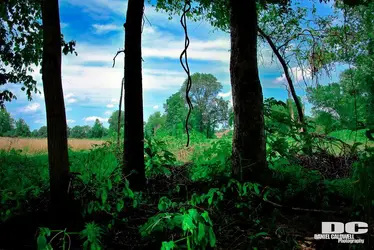i had a version with more road from what you all were saying sounds more like wasted negative space and i was hearing zoom in tighter.. i did have a version showing more of the road but i think i liked this one best. i did take it from a few focal lenghts and all of that. i was using my 18-200mm lens on this one.
i have drove down the road a few times and though that might make a nice shot so this is the first spot i hit, than i walked around teh block and shot a few other things but nothing that interesting.
You've been given a buzzword, "negative space", which I don't feel you have fully understood.
This example somewhat relates to a lesson I recall from the "Drawing from the Right Side of the Brain" textbook. To draw a teacup, do not look at the shape of the actual cup. If you want to draw the shape of the handle, concentrate on the lines which form and the space encapsulated by those lines which are the inside of the handle as it connects to the outside of the cup itself. You might want to give this exercise a try to better your comprehension of what negative space is and how to employ it to your best advantage.
Drawing 3 - Drawing the negative spaces
The idea of using negative space in illustration and design is to free your mind of pre-conceived ideas of how something looks or "is". Very much like flipping the image upside down for the non-visual personality type, you are seeing reality in a new and unrealistic manner.
If you are asked to draw an illustration of a chair, most people will rely on their life long concept of "a chair" to do so. By removing the positive space image of a chair from your memory and forcing you to view only that space/line which defines the negative space not physically occupied by the chair, your mind is freed from its conventional views of how things exist. This allows you to see those things which you have always accepted as "chair" or "cup" in entirely new ways.
"Seeing" is the major impediment the tactile/auditory personality has as they approach composition.
Negative space is not necessarily "space". And, certainly not always space occupied by something.
Do not think of the water in either of your previous examples as "negative space". It is very positive space which is being defined by the negative space which surrounds it. And vice versa.
As with the optical illusions which flip your brain back and forth between seeing this then that, positive and negative space can be either at any one time also;
50 Mesmerising Designs That Make The Most Of Negative Space – Design School
The water in either image is not negative when it is a very active player in the composition. (not "competition") Water has color and texture. It has life. It is dynamic and it is calm. It is pure and it is putrid. It is rising and it is falling.
It is, most of all, symbolic.
It is contained by something with a line. Once there is a line, there must be space. Lines keep our mind active or they allow it rest.
If you looked deeply into either of your previous examples, you could experience your mind slipping into a Theta brainwave pattern. Theta brainwaves register at about 4.0 - 7.5 Hz which is where your mind settles just before you drift off to sleep in most cases.
theta brainwave patterns - Google Search
Theta is a state of mind which is highly relaxed yet vividly attentive. It is the experience many marijuana users report as their perceptual high when, say, listening to music after smoking. Or viewing a painting or photograph. Someone drinking moderate amounts of alchohol may also find themself in this same restfully alert state of mind. Someone listening to binaural or isochronic waves can place their brainwave patterns intentionally in this range of frequencies which can simulate marijuana's relaxed high.
(More interesting to a neuro-scientist and those who study the cognitive sciences of perception is the fact the Schumann Resonance is measured just beyond this range at 7.83Hz. Early space travel showed astronauts returning to Earth after a period of time outside of the effects of the Schumann Resonance left them disoriented to some degree. Eventually, NASA began to include Schumann Resonance generators in the US space capsules to alleviate this problem. Humans both respond to this frequency and need this frequency.
schumann resonance - Google Search You asked why those two images "worked". This is partially an explanation of their effect on your mind, your cognition, and why many people will intuitively respond to these images.)
Therefore, the elements included in your previous two examples are all hitting on major themes which humans respond to intuitively and naturally. Negative space is defining the existence of these elements but it is not the elements themself.
Therefore, "road" = negative space misses the mark.
Meet Your Brain Waves — Introducing Alpha, Beta, Theta, Delta, And Gamma
This Is Your Brain. This Is Your Brain On Music
The Schumann's Resonances and Human Psychobiology - extended version
Obviously, you can take excellent photographs without any discrete knowledge of these concepts. And forcing yourself to find these elements in your viewfinder will typically result in your images looking as though you forced them into the frame. Visual personality types tend to easily spot these elements while tactile and auditory types must learn to recognize them when and where they exist.
But do not mis-use the concepts either. Just as always using the rule of thirds (particularly if you always favor placing objects on the same side of the frame) will quickly become boring, diversity in your photography pays off.
You are rushing things to get to an end. That is exactly what you should not be doing. You are not seeing what it is you are going to take a photo of.
photography and pre-visualization - Google Search
IMO you would benefit from not trying so hard to "get" landscapes.
Next time you go out, find an object you feel is photo worthy. Then take your time, even to the extent of spending several hours in one spot. Don't take photos just to be taking photos. Stay and observe how light and shadow change the object through the day.
An alternate rule of thirds is this; your first thoughts about an image are always wrong.
Your second thoughts about the same image are equally poor.
Your third thought about how to compose an image may be correct.
Select your one object and take as many photos as you feel you need, in as much time as required, in order to show the object in what you feel is its true essence. In other words, if you like a park bench, show how many ways that object can display its full "park benchness".
Think symbols.
Think line.
Think what isn't.
think contrast.
think color.
think what was.
think what can be.
Think why.
think again.
Where is the negative space in this first image?
Understanding and Using "Negative Space" in Photography | Photography Mad
Your example of a nightime image of the stork is very much like the Japanese woodcuts of The Floating World;
Overview - The Floating World of Ukiyo-e | Exhibitions - Library of Congress
Such Japanese art is non-representational. Realistic (enough) images are used as symbols of themes. Composition is ruled by the symbolism.
No need to learn symbolism at this point. However, show us a photo which you feel contains symbols and symbolism.
Leave landscapes go by for now.






















![[No title]](/data/xfmg/thumbnail/38/38723-12789924db409b40399a402700ac823c.jpg?1734172598)


![[No title]](/data/xfmg/thumbnail/32/32810-094482c1ef1c76eae62a96107013a72e.jpg?1734162496)

